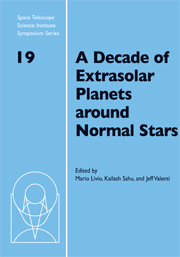 A Decade of Extrasolar Planets around Normal Stars
A Decade of Extrasolar Planets around Normal Stars Published online by Cambridge University Press: 22 October 2009
The Doppler technique has continuously improved its precision during the past two decades, attaining the level of 1 ms−1. The increasing precision opened the way to the discovery of the first extrasolar planet, and later, to the exploration of a large range of orbital parameters of extrasolar planets. This ability to detect and characterize in great detail companions down to Neptune-mass planets has provided many new and unique inputs for the understanding of planet formation and evolution. In addition, the success of the Doppler technique introduced a great dynamic in the whole domain, allowing the exploration of new possibilities.
Nowadays, the Doppler technique is no longer the only means to discover extrasolar planets. The performance of new instruments, like the High Accuracy Radial-velocity Planet Searcher (HARPS), has shown that the potential of the Doppler technique has not been exhausted; Earth-mass planets are now within reach. In the future, radial velocities will also play a fundamental role in the follow-up and characterization of planets discovered by means of other techniques—for transit candidates, in particular. We think, therefore, that the follow-up of candidates provided by, e.g., the COnvection, ROtation and planetary Transits (COROT) and Kepler space telescopes, will be of primary importance.
To save this book to your Kindle, first ensure [email protected] is added to your Approved Personal Document E-mail List under your Personal Document Settings on the Manage Your Content and Devices page of your Amazon account. Then enter the ‘name’ part of your Kindle email address below. Find out more about saving to your Kindle.
Note you can select to save to either the @free.kindle.com or @kindle.com variations. ‘@free.kindle.com’ emails are free but can only be saved to your device when it is connected to wi-fi. ‘@kindle.com’ emails can be delivered even when you are not connected to wi-fi, but note that service fees apply.
Find out more about the Kindle Personal Document Service.
To save content items to your account, please confirm that you agree to abide by our usage policies. If this is the first time you use this feature, you will be asked to authorise Cambridge Core to connect with your account. Find out more about saving content to Dropbox.
To save content items to your account, please confirm that you agree to abide by our usage policies. If this is the first time you use this feature, you will be asked to authorise Cambridge Core to connect with your account. Find out more about saving content to Google Drive.